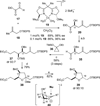Total synthesis of (+)-azaspiracid-1. An exhibition of the intricacies of complex molecule synthesis
- PMID: 19006391
- PMCID: PMC3408805
- DOI: 10.1021/ja804659n
Total synthesis of (+)-azaspiracid-1. An exhibition of the intricacies of complex molecule synthesis
Abstract
The synthesis of the marine neurotoxin azaspiracid-1 has been accomplished. The individual fragments were synthesized by catalytic enantioselective processes: A hetero-Diels-Alder reaction to afford the E- and HI-ring fragments, a carbonyl-ene reaction to furnish the CD-ring fragment, and a Mukaiyama aldol reaction to deliver the FG-ring fragment. The subsequent fragment couplings were accomplished by aldol and sulfone anion methodologies. All ketalization events to form the nonacyclic target were accomplished under equilibrating conditions utilizing the imbedded configurations of the molecule to adopt one favored conformation. A final fragment coupling of the anomeric EFGHI-sulfone anion to the ABCD-aldehyde completed the convergent synthesis of (+)-azaspiracid-1.
Figures

























Similar articles
-
Total synthesis and structural elucidation of azaspiracid-1. Final assignment and total synthesis of the correct structure of azaspiracid-1.J Am Chem Soc. 2006 Mar 8;128(9):2859-72. doi: 10.1021/ja054750q. J Am Chem Soc. 2006. PMID: 16506764
-
Total synthesis of (+)-azaspiracid-1. Part II: synthesis of the EFGHI sulfone and completion of the synthesis.Angew Chem Int Ed Engl. 2007;46(25):4698-703. doi: 10.1002/anie.200701520. Angew Chem Int Ed Engl. 2007. PMID: 17546578 No abstract available.
-
Total synthesis of (+)-azaspiracid-1. Part I: Synthesis of the fully elaborated ABCD aldehyde.Angew Chem Int Ed Engl. 2007;46(25):4693-7. doi: 10.1002/anie.200701515. Angew Chem Int Ed Engl. 2007. PMID: 17546577 No abstract available.
-
Synthetic study of azaspiracid-1: synthesis of the EFGHI-ring fragment.Org Lett. 2006 Aug 31;8(18):3943-6. doi: 10.1021/ol0613766. Org Lett. 2006. PMID: 16928044
-
Spiroimine shellfish poisoning (SSP) and the spirolide family of shellfish toxins: isolation, structure, biological activity and synthesis.Nat Prod Rep. 2010 Sep;27(9):1350-66. doi: 10.1039/c005400n. Epub 2010 Jun 29. Nat Prod Rep. 2010. PMID: 20585694 Review. No abstract available.
Cited by
-
Constructing molecular complexity and diversity: total synthesis of natural products of biological and medicinal importance.Chem Soc Rev. 2012 Aug 7;41(15):5185-238. doi: 10.1039/c2cs35116a. Epub 2012 Jun 28. Chem Soc Rev. 2012. PMID: 22743704 Free PMC article. Review.
-
Bis{(R)-N-[(R)-2-benz-yloxy-1-(4-tert-butyl-phen-yl)eth-yl]-2-methyl-propane-2-sulfinamide} monohydrate.Acta Crystallogr Sect E Struct Rep Online. 2014 Mar 8;70(Pt 4):o405-6. doi: 10.1107/S1600536814004589. eCollection 2014 Apr 1. Acta Crystallogr Sect E Struct Rep Online. 2014. PMID: 24826122 Free PMC article.
-
Catalytic Addition of Simple Alkenes to Carbonyl Compounds Using Group 10 Metals.Synlett. 2009 Oct 1;2009(16):2565-2582. doi: 10.1055/s-0029-1217747. Synlett. 2009. PMID: 21904421 Free PMC article.
-
Stereocontrolled cyanohydrin ether synthesis through chiral Brønsted acid-mediated vinyl ether hydrocyanation.J Org Chem. 2013 Sep 20;78(18):9366-76. doi: 10.1021/jo4016002. Epub 2013 Sep 4. J Org Chem. 2013. PMID: 23968162 Free PMC article.
-
Asymmetric catalytic synthesis of the proposed structure of trocheliophorolide B.Org Lett. 2012 Sep 7;14(17):4698-700. doi: 10.1021/ol302074h. Epub 2012 Aug 22. Org Lett. 2012. PMID: 22913543 Free PMC article.
References
-
- McMahon T, Silke J. Harmful Algae News. 1996;14:2.
-
- James KJ, Furey A, Lehane M, Ramstad H, Aune T, Hovgaard P, Morris S, Higman W, Satake M, Yasumoto T. Toxicon. 2002;40:909–915. - PubMed
-
- Magdalena AB, Lehane M, Krys S, Fernandez ML, Furey A, James KJ. Toxicon. 2003;42:105–108. - PubMed
-
- James KJ, Moroney C, Roden C, Satake M, Yasumoto T, Lehane M, Furey A. Toxicon. 2003;41:145–151. - PubMed
-
- Taleb H, Vale P, Amanhir R, Benhadouch A, Sagou R, Chafik A. J. Shellfish Res. 2006;25:1067–1070.
Publication types
MeSH terms
Substances
Grants and funding
LinkOut - more resources
Full Text Sources
Other Literature Sources

